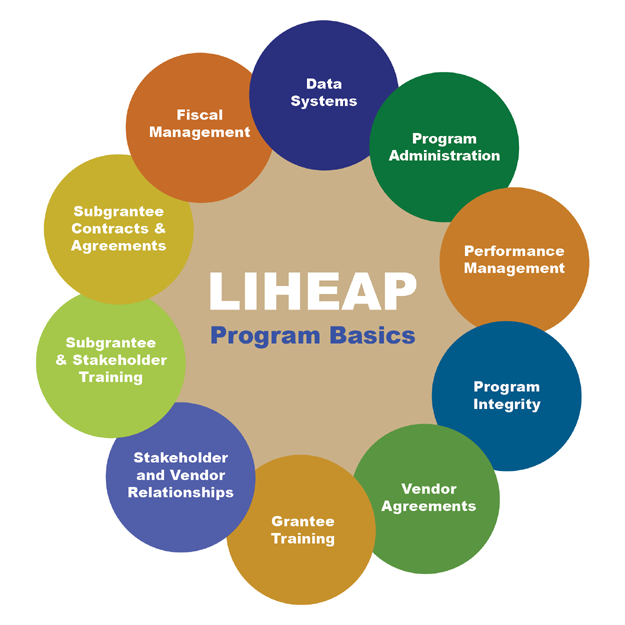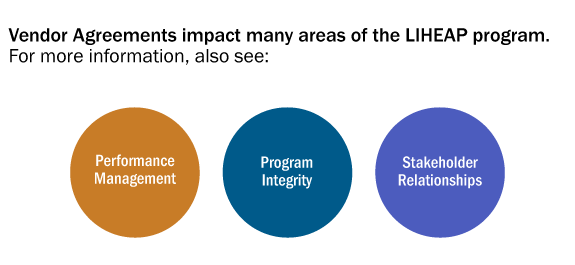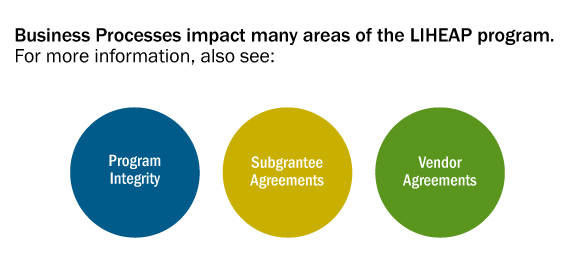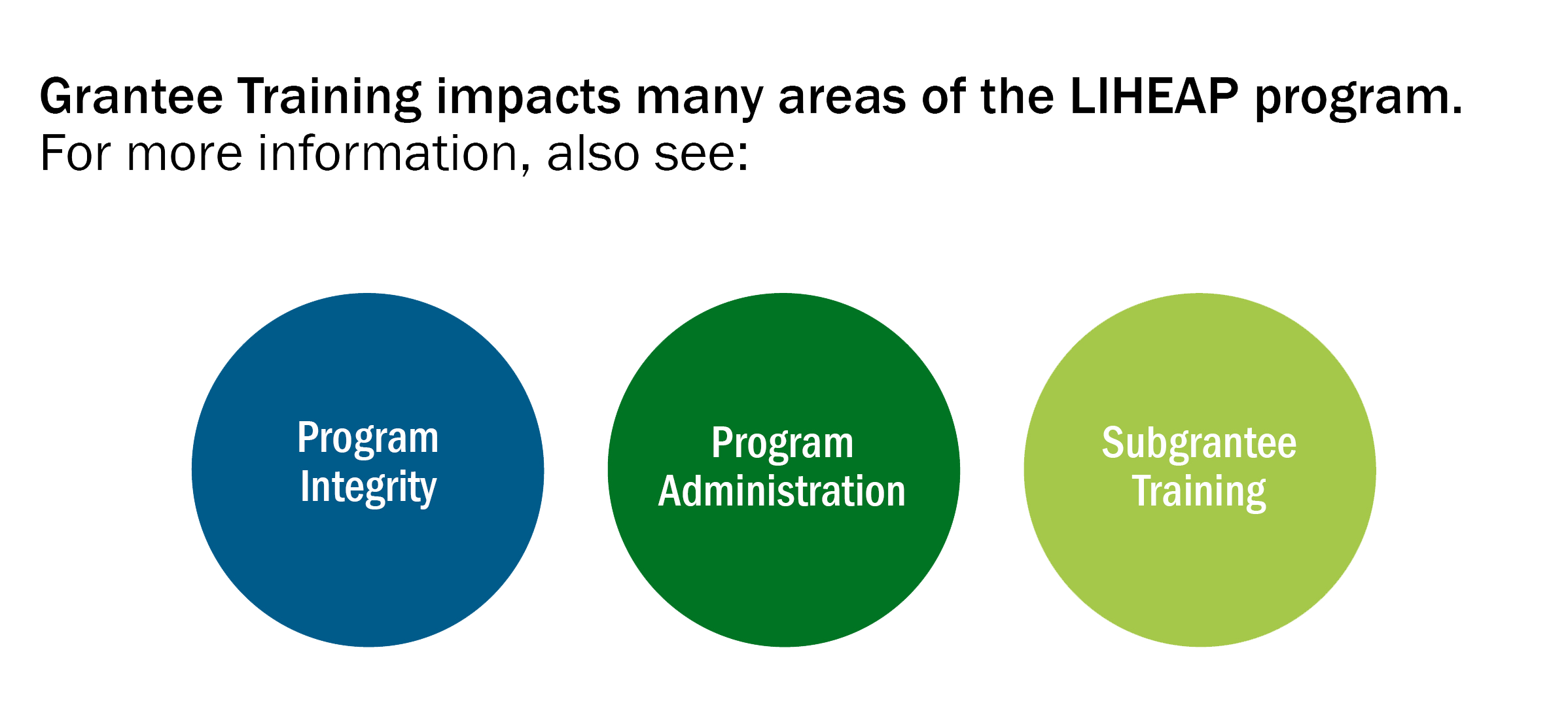LIHEAP Virtual Library
 The LIHEAP Virtual Library allows grantees to locate resources based on their unique needs. This tool not only provides basic T/TA resources for each area, but also highlights those areas where Performance Management and the everyday administration of LIHEAP intersect. To begin, select an area of interest. The tool will allow you to select and review multiple program areas before generating resources.
The LIHEAP Virtual Library allows grantees to locate resources based on their unique needs. This tool not only provides basic T/TA resources for each area, but also highlights those areas where Performance Management and the everyday administration of LIHEAP intersect. To begin, select an area of interest. The tool will allow you to select and review multiple program areas before generating resources.
|
To remove a resource from your toolbox, click the [x].

|
LIHEAP PERFORMANCE MANAGEMENT SNAPSHOT
Performance management is the process of gathering performance measurement data (both mandatory and voluntary), and then using this information to make informed program decisions.
Why is this important?
Performance Management helps states do a better job of evaluating and improving their LIHEAP programs. This includes targeting resources to reduce energy burden and to maintain continuous home energy service for low-income households. LIHEAP performance measure data will also allow HHS to more consistently demonstrate national program results.
Who says so?
In November 2014, HHS received approval from the federal Office of Management and Budget (OMB) to proceed with requiring state LIHEAP grantees to collect and report on four new performance measures related to home energy burden and continuity of home energy service. See more here...
Highlighted Resources:
The following resources related to LIHEAP business processes are included in the Virtual Library. Note: This list is not comprehensive.
Download files individually by clicking the links or use the checkboxes to add them to your toolbox.
Back to main page
Ways to use these resources:
- Review the basics. Use training slides, overviews, and FAQ documents to get a better understanding of LIHEAP Performance Measure requirements.
- Identify what data you are currently collecting. Many states are already collecting the data needed to meet part or all of the Performance Measure requirements.
- Pinpoint data gaps and make necessary changes. Does your application, client information waiver, and/or vendor agreement need to be updated to collect data necessary for Performance Measurement? Do fields need to be added to your current system? Do you need to collect different data from subgrantees?
- Partner with vendors. Many states report that working alongside vendors to implement LIHEAP Performance Management makes the process easier.
- Collaborate with peers. Many home energy suppliers have multi-state territories. Working together with grantees who "share" a vendor may help when negotiating new or updated vendor data exchanges.
- Use the Data Quality guide to assure the data you are collecting is accurate and reliable. Looking ahead, are there specific steps you can take to improve the data you are collecting and reporting each year?
- Review your state LIHEAP Performance Measure Executive Summary and Snapshot. What impact is LIHEAP having in your state? How does this compare with your state program goals?
- Use the "Talking Points" examples and templates to share Performance Measure data with your leadership, subgrantees, vendors, legislators, and other stakeholders. How does Performance Measure data jive with what partners are seeing on the ground? Can partners provide context that makes the data more meaningful? How does the information affirm (or call into question) statewide program goals? How can subgrantees and vendors help to improve data collection over time?
 |
 Return to Tool Return to Tool
|
LIHEAP VENDOR AGREEMENTS SNAPSHOT
Vendor Agreements formally define the relationship between home energy suppliers (vendors), LIHEAP grantees, subgrantees, and clients. This includes the roles and responsibilities of each party.
Why is this important?
Vendor agreements protect households from adverse treatment and assure that LIHEAP payments are accurately applied to energy bills. Vendor agreements also define expectations in terms of payment timelines, refunds, and data exchanges between the home energy supplier and grantee (and/or subgrantees).
Who says so?
The requirement for grantees to establish agreements with utility vendors receiving LIHEAP payments stems from Assurance 7 of the LIHEAP statute (Section 2605(b)(7)).
How do I learn more?
The following resources related to LIHEAP business processes are included in the Virtual Library. Note: This list is not comprehensive.
Download files individually by clicking the links or use the checkboxes to add them to your toolbox.
Back to main page
Ways to use these resources:
- Take a look at your vendor agreement. Does it cover everything it needs to? Are there areas that should be updated or revised?
- Read through examples of other grantee vendor agreements. Are there ideas you would like adopt or consider for your own state?
- Keep an eye on strengthening program integrity. Can areas of your vendor agreement be revised, or new areas added to reduce the potential for fraud, waste, and abuse?
- Partner with vendors. Many states report that working alongside vendors to update agreements makes the process easier for everyone.
- Collaborate with peers. Many home energy suppliers have multi-state territories. Working together with grantees who "share" a vendor may help when negotiating new or updated vendor agreements.
 |
 Return to Tool Return to Tool
|
LIHEAP PROGRAM ADMINISTRATION SNAPSHOT
LIHEAP Program Administration encompass the policies, procedures, structures, and systems necessary to effectively administer LIHEAP. This includes compliance with minimum federal requirements.
Why is this important?
LIHEAP Program Administration describe how grantees administer the program. Business processes must be outlined each year in the LIHEAP Block Grant Application (Model Plan). This includes how the grantee will comply with the federal LIHEAP statute and other legal requirements of the program.
Who says so?
Grantees are required to complete an annual Model plan to include eligibility requirements, benefit levels, and steps taken to carry out LIHEAP Assurances (sections 2605(c) and 2605(d)).
How do I learn more?
The following resources related to LIHEAP Program Administration are included in the Virtual Library. Note: This list is not comprehensive.
Download files individually by clicking the links or use the checkboxes to add them to your toolbox.
Back to main page
Ways to use these resources:
- Identify what you already have in place. Comparing basic grantee roles and responsibilities with the processes currently being employed will help you identify areas where improvement is needed.
- Pinpoint areas for potential improvement. In addition to identifying gaps within your own processes, review model plans and examples from other states and tribes. These may help you find opportunities for growth or change.
- Collaborate with peers. LIHEAP grantees utilize diverse business processes to meet program requirements. Many of these enhance the efficiency and effectiveness of service delivery. Reaching out to peers in other states and/or tribes may provide new ideas or creative insight as you consider development, updates, or redesign of your own business processes.
- Collaborate with subgrantees and other stakeholders. Most business processes associated with LIHEAP require coordination with other departments, partners, and vendors. Collaborating with stakeholders to develop business processes encourages broader understanding of federal LIHEAP requirements—but also results in program design that meets the diverse needs of partners, vendors, and clients.
 |
 Return to Tool Return to Tool
|
LIHEAP PROGRAM INTEGRITY SNAPSHOT
Program integrity means that LIHEAP funds are efficiently expended in compliance with program expectations, and in a fiscally responsible manner. In other words, program integrity assures that LIHEAP dollars are spent as they are intended.
Why is this important?
In addition to addressing improper payments, waste, fraud, and abuse—LIHEAP program integrity efforts are intended to assure efficient, quality services to low-income households. Program Integrity impacts all aspects of LIHEAP. This includes policy development, program design, data systems, client intakes, payment processes, monitoring, and evaluation.
Who Says So?
According to LIHEAP Statute, LIHEAP grantees must establish fiscal control and fund accounting procedures in order to assure the proper disbursal of and accounting for federal LIHEAP funds (Section 2605 (b)(10)). Additionally, LIHEAP grantees are required to report annually on their systems (policies and processes) for ensuring program integrity. This includes provisions to prevent waste, fraud, and abuse—as well as efforts to assure vendor validity.
Highlighted Resources:
The following resources related to LIHEAP business processes are included in the Virtual Library. Note: This list is not comprehensive.
Download files individually by clicking the links or use the checkboxes to add them to your toolbox.
Back to main page
Ways to use these resources:
- Get the background. Review the June 2010 GAO Report, as well as the LIHEAP Program Integrity Work Group Report, to learn more about why Program Integrity is important.
- Identify what steps you’ve already taken. Many grantees have already changed policies or processes to mitigate improper payments, waste, fraud, and abuse in various areas of their program.
- Pinpoint areas for potential improvement. The LIHEAP Program Integrity Work Group Report outlines ways grantees can increase integrity across multiple program elements. The recommendations in this report can be used to help your state or tribe identify areas where stronger controls are needed.
- Collaborate with social service partners. One recommendation to increase program integrity includes third party verification of household eligibility data. This often requires data exchange agreements (or developing shared data systems) with other state agencies or departments.
- Collaborate with peers. LIHEAP grantees have worked to improve Program Integrity in diverse and creative ways. Don’t be afraid to reach out for help with problem solving, or to share ideas.
 |
 Return to Tool Return to Tool
|
LIHEAP GRANTEE TRAINING SNAPSHOT
The Department of Health and Human Services, Office of Community Services, Division of Energy along with several LIHEAP contractors and professional organizations provide grantee training opportunities to assisted grantees in administering the LIHEAP Block Grant.
Why is this important?
Training assures that LIHEAP Grantees have the resources necessary to run efficient, effective programs. This includes ensuring that Grantees understand their roles and responsibilities as outlined in LIHEAP Statute and other program regulations.
Who says so?
Section 2609(a) of the LIHEAP Statute indicates that HHS may use LIHEAP funding to provide training and technical assistance to grantees. Additionally, these monies may also be used to conduct compliance reviews.
Highlighted Resources:
The following resources related to LIHEAP business processes are included in the Virtual Library. Note: This list is not comprehensive.
Download files individually by clicking the links or use the checkboxes to add them to your toolbox.
Back to main page
Ways to use these resources:
- Be sure to access all types of training. Some grantees may not be able to travel to regional or national training conferences. However, resources from these conferences are posted on the OCS training website. Additionally, webinars are frequently offered throughout the year and available online.
- Become a peer mentor or mentee.. Many grantees will tell you that the most valuable training and technical assistance comes from their peers. The self-assessment tool provides peer mentor and mentee sign-up sheets.
- Be proactive. Let OCS and/or their contractors know the types of training and technical assistance you need to successfully administer LIHEAP. Watch for opportunities to discuss LIHEAP issues and solutions with regional or national peers, Use the forum board on the Performance Measurement website, and get involved with work groups.
 |
 Return to Tool Return to Tool
|
LIHEAP DATA SYSTEMS SNAPSHOT
LIHEAP data systems vary widely among grantees in terms of integration and sophistication. LIHEAP data systems can also be used for diverse program functions. These include but are not limited to intake, eligibility determination, payment processing, accounting, risk management, reporting, and performance evaluation.
Why is this important?
Data systems help grantees meet minimum federal program expectations. This includes federal reporting requirements, as well as fiscal control and fund accounting procedures. Additionally, many grantees use systems to increase payment efficiency, reduce improper (e.g., duplicate) benefits, and utilize third party data to verify household eligibility.
Who Says So?
Grantees are required to cooperate with HHS with respect to data collection and reporting outlined in the LIHEAP statute (sections 2605 (b)(14) and 2610). Additionally, LIHEAP grantees must establish fiscal control and fund accounting procedures in order to assure the proper disbursal of and accounting for federal LIHEAP funds (section 2605 (b)(10)).
Highlighted Resources:
The following resources related to LIHEAP business processes are included in the Virtual Library. Note: This list is not comprehensive.
Download files individually by clicking the links or use the checkboxes to add them to your toolbox.
Back to main page
Ways to use these resources:
- Identify what you already have in place. Understanding what current LIHEAP systems exist in your state (and how they work together) will help you identify areas where your data system may be improved.
- Pinpoint areas for potential improvement. Many existing reports and trainings (e.g., LIHEAP Program Integrity Work Group Report, Performance Measure Data Collection Guide) outline areas grantees should consider during development, update, or redesign of their data systems.
- Visualize an end product and work backwards. What reports would you like to generate from your system? How could your system improve program design? Visualizing your “ideal” end result will make it easier to begin planning and design processes.
- Collaborate with peers. LIHEAP grantees utilize diverse data systems (or sets of systems) to meet program requirements. Many of these data systems also enhance the efficiency and effectiveness of service delivery. Reaching out to peers in other states and/or tribes may provide new ideas or creative insight as you consider development, updates, or redesign of your own data systems.
- Collaborate with social service partners. Many states/tribes integrate their systems or develop shared databases with other social service programs. This allows them to use third party data to verify household eligibility data.
 |
 Return to Tool Return to Tool
|
LIHEAP SUBGRANTEE CONTRACTS AND AGREEMENTS SNAPSHOT
Subgrantee contracts and agreements formally define the relationship between LIHEAP grantee, local administering agency, and clients. This includes expectations, roles, and responsibilities of each party.
Why is this important?
Subgrantee contracts and agreements outline how local agencies will administer LIHEAP funding. This includes, but is not limited to providing LIHEAP applications, completing LIHEAP applications, determining eligibility and benefit levels, processing LIHEAP benefit payments, and conducting local outreach. Additionally, subgrantee contracts and agreements establish expectations in terms of oversight and accountability (e.g., data exchanges, fiscal integrity, monitoring requirements).
Who says so?
The requirement for grantees to establish subgrantee contracts and agreements stems from Assurance 10 of the LIHEAP statute (Section 2605(b)(10)). OMB Uniform Administrative Requirements also mandate that subgrantees know the requirements, regulations, terms and conditions of their award (45 CFR Part 75).
Highlighted Resources:
The following resources related to LIHEAP business processes are included in the Virtual Library. Note: This list is not comprehensive.
Download files individually by clicking the links or use the checkboxes to add them to your toolbox.
Back to main page
Ways to use these resources:
- Take a look at your subgrantee contacts and agreements. Do they cover everything they need to? Are there areas that should be updated or revised?
- Read through examples of other grantee subgrantee contracts and agreements. Are there ideas you’d like adopt or consider for your own state?
- Keep an eye on strengthening program integrity. Can areas of your subgrantee contracts and agreements be revised, or new areas added to reduce the potential for fraud, waste, and abuse?
- Partner with subgrantees. Many grantees report that working alongside subgrantees to update agreements makes the process easier for everyone.
- Align program elements. Be sure that the expectations spelled out in the State Plan, policy manuals, monitoring tools, data exchange agreements, and risk assessments align with the terms and conditions in subgrantee contracts and agreements.
 |
 Return to Tool Return to Tool
|
LIHEAP SUBGRANTEE AND STAKEHOLDER TRAINING SNAPSHOT
Subgrantee and stakeholder training is necessary to assure that LIHEAP funds are administered in compliance with federal LIHEAP statute, as well as any state/tribal program regulations.
Why is this important?
Training assures that LIHEAP stakeholders have the resources and knowledge necessary to administer LIHEAP in an efficient, effective, and compliant manner. This includes ensuring that stakeholders understand their roles and responsibilities as outlined in federal, state, and tribal regulations.
Who says so?
The LIHEAP Model State Plan requires grantees to outline how they will train subgrantees, vendors (Section 15, Program Integrity). The LIHEAP Statute also requires that vendors understand the rules of LIHEAP, and apply benefits in a timely and appropriate manner (2605(b)(7)).
Highlighted Resources:
The following resources related to LIHEAP business processes are included in the Virtual Library. Note: This list is not comprehensive.
Download files individually by clicking the links or use the checkboxes to add them to your toolbox.
Back to main page
Ways to use these resources:
- Be sure to access all types of training. Some grantees may not be able to travel to regional or national training conferences. However, resources from these conferences are posted on the OCS training website. Additionally, webinars are frequently offered throughout the year and available online.
- Become a peer mentor or mentee.. Many grantees will tell you that the most valuable training and technical assistance comes from their peers. The self-assessment tool provides peer mentor and mentee sign-up sheets.
- Be proactive. Let OCS and/or their contractors know the types of training and technical assistance you need to successfully administer LIHEAP. Watch for opportunities to discuss LIHEAP issues and solutions with regional or national peers, Use the forum board on the Performance Measurement website, and get involved with work groups.
 |
 Return to Tool Return to Tool
|
LIHEAP STAKEHOLDER AND VENDOR RELATIONSHIPS SNAPSHOT
Stakeholders are parties that have an interest or stake in LIHEAP. These can include LIHEAP customers, staff, sub grantee staff, utility companies, municipalities, coops, deliverable fuel suppliers, vendor profession associations, public utility commission.
Why is this important?
Coordination and collaboration with stakeholders assure that low-income households have access to LIHEAP when and how they need it most. Collaboration also leverages the skills, resources, and advocacy of those outside of LIHEAP necessary to assist low-income households in terms of energy needs.
Who says so?
Public participation is required in the development and approval of the annual LIHEAP Model State Plan (2605(b)(12)). Additionally, the statute requires that grantees work with relevant stakeholders to provide outreach to clients and coordinate services (2605(b)(3) and 2605(b)(4)).
How do I learn more?
The following resources related to LIHEAP business processes are included in the Virtual Library. Note: This list is not comprehensive.
Download files individually by clicking the links or use the checkboxes to add them to your toolbox.
Back to main page
Ways to use these resources:
- Identify what you already have in place. Does your state already collaborate with stakeholders? Are there areas where you could do a better job engaging customers, local providers, or vendors?
- Pinpoint areas for potential improvement. Review examples of relationship building from other states and tribes. These may help you find opportunities for growth or change.
- Reach out to your partners and just ask. You don't need to have a sophisticated stakeholder plan in place to build relationships. The best relationships are built through small interactions over time. For example, when you have a policy challenge or unanswered question—reach out to partners to help brainstorm.
- Don't forget low-income households. Engaging customer households can sometimes be a challenge. One way to start this process is a customer service survey. Finding out what households need, as well as the ways they’d like to have input may give you the information necessary to start developing a more detailed customer engagement plan.
 |
 Return to Tool Return to Tool
|
LIHEAP FISCAL MANAGEMENT SNAPSHOT
Pending...
I Need Help Using this Tool
Do you need help using the LIHEAP Virtual Library?
Please use the form below to submit a help request.
Your submission will be forwarded to appropriate staff immediately. Thank you!
Suggest Resources
Do you have files and resources you'd like to share with other Grantees? Please suggest them here. Thank you!